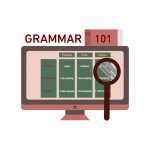English Grammar 101

الوصف
على طريقة فلكس كورسز، تعلم أساسيات قواعد اللغة الإنجليزية وذلك من خلال دورة مخصصة لتعليم اللغة الإنجليزية لغير الناطقين بها.
في هذه الدورة سنقوم بالعمل سويا على تأسيس لغتك الإنجليزية وهذه الدورة ليست منطوقة بالإنجليزية بشكل كامل حيث أنها موجهة للمبتدئين في تعلم قواعد الإنجليزية.
سنتعلم في هذه الدورة القواعد اللازمة لتكوين الجملة الإنجليزية وذلك من خلال الكثير من التمارين والأمثلة التي سوف تزيد من مهارتك وثقتك باستخدامك للغة.
ماذا سنتعلم في هذه الدورة؟
- Using Be
- Using Be and Have
- Simple Present Tense
- Present Progressive
- Talking about the present
- Nouns and pronouns
- Count and noncount nouns
- Expressing past time
- Expressing future time
- Modals
- Nouns and modifiers
- Possessives
- Making comparisions
المدرب
الأقسام
Introduction to English Grammar 101
An introduction to the course, the tutor and the content.
USING BE
The verb be is used as an auxiliary verb and it can also be used as a main verb. The verb be is irregular. It has many forms
USING BE AND HAVE
Understanding the use of be and have in a verity of situations and forming questions
USING THE SIMPLE PRESENT
The simple present is a verb tense with two main uses. We use the simple present tense when an action is happening right now, or when it happens regularly
USING THE PRESENT PROGRESSIVE
Present progressive is a verb construction comprised of a present form of the verb "to be" plus a present participle that usually conveys a sense of ongoing action at the present time.
TALKING ABOUT THE PRESENT
explaining the present tense to describe a whole range of events that are happening in the present time.
NOUNS AND PRONOUNS
Nouns and pronouns are the “things” in our sentences—the things that complete actions (or have things done to them).
COUNT AND NONCOUNT NOUNS
A "count noun" is a noun that can be counted. It can also be singular or plural, and it can be used with a singular or plural verb. A "noncount noun" cannot be counted, cannot be plural, and cannot be used with a plural verb
EXPRESSING PAST TIME, PART 1
past time expressions, which is related to the grammar structure simple past. and it is used to say when something happened in the past.
EXPRESSING PAST TIME, PART 2
Continuing part 1
EXPRESSING FUTURE TIME, PART 1
Future time expressions, which is related to the grammar structure simple future . and it is used to say when something will happen in the future .
EXPRESSING FUTURE TIME, PART 2
Continuing part 1
MODALS, PART 1: EXPRESSING ABILITY
Ability can be expressed using modal verbs and phrases. we will be looking at the most used modals in English
MODALS, PART 2: ADVICE, NECESSITY, REQUESTS, SUGGESTIONS
Continuing part 1
NOUNS AND MODIFIERS
A noun can modify another noun that follows it. As a modifier, the first noun gives specific information about the following noun. In nearly all cases, the noun that acts as the modifier is in singular form.
POSSESSIVES
Possessives are forms that we use to talk about possessions and relationships between things and people or other things. They take different forms depending on how they are used.
MAKING COMPARISONS
Adjectives and adverbs can be used to make comparisons. The comparative form is used to compare two people, ideas, or things.
End of course resources
Well.. This is the end of the course.
عينة من الدروس المجانية
-
Introduction to the course
This is an introduction to the course, the teacher and the teaching methodology
المدة: 06:16
-
American and British English
In this lesson we'll talk about the differences between British and American English
المدة: 05:00
-
Introduction BE verb
? What is BE verb
المدة: 02:50
-
Negative with be
using be + not in singular and plural forms
المدة: 05:05
-
Exercise 1-5
المدة: 08:20
-
Be + a place
Using be + place to locate where someone or somthing is
المدة: 08:55
-
Using be and have introduction
The different uses of be and have
المدة: 01:32
-
Form and basic meaning of the simple present tense
المدة: 08:45
-
The Present Progressive: negative
المدة: 01:47
-
Using it to talk about time
المدة: 04:08
-
Nouns: subjects and objects
المدة: 06:48
-
Using a/an vs. some
المدة: 02:38
-
The simple past: negative
المدة: 03:08
-
When in time clauses
المدة: 02:49
-
Future time: Using be going to
المدة: 05:36